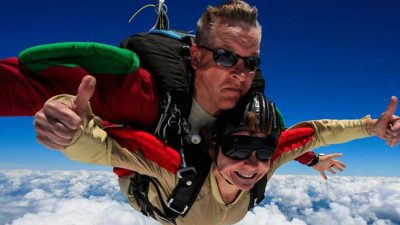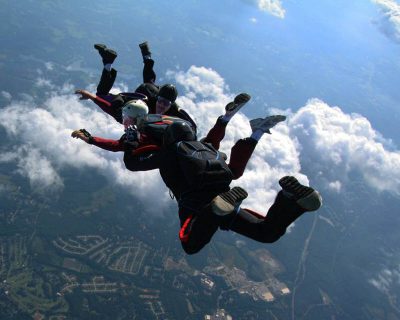Freefall is perhaps the most exciting and most mysterious portion of jumping out of an airplane. There’s nothing in life that can compare to the feeling of freefall speed, and understanding skydiving terminal velocity often comes with confusion and misinformation.
Fortunately, a bit of science talk can clear up skydiving velocity and help you feel a little more confident about what your tandem skydive terminal velocity will feel like. Check out this article to answer the question: How fast does a human fall from the sky?
How Fast is Freefall?
One of the best parts of jumping out of an airplane is freefall and the freedom that comes with speed. But at what speed do you fall while skydiving? You may have heard “120 mph” thrown around when referencing tandem skydive terminal velocity. And that’s correct … mostly.
So, 120 mph is the average speed at which skydivers fall when flying on their bellies. Holding an arch position and falling on your belly is the default way to skydive because it’s the easiest body position to learn and the most stable position to fall in.
That being said, there are a lot of factors that go into freefall speed, including body position, clothing, and weight. Freefall speed while skydiving can even change from one jump to the next depending on how the skydiver alters each element of the jump. The current world record for the fastest freefall is held by Henrik Raimer, who managed to reach a speed of 373.6mph on his record-breaking jump!
But what about terminal velocity? Doesn’t the human body hit a pre-established top speed and that’s it? How can someone fall over 300 miles per hour??
How Does Terminal Velocity Work While Skydiving?
Terminal velocity is a lot more fluid than you might think. Rather than applying to the human body in a general sense, each specific situation has its own terminal velocity. Breaking down the official definition of terminal velocity may help with understanding:
- Terminal velocity is the constant speed that a freely falling object eventually reaches when the resistance of the medium through which it is falling prevents further acceleration.
 The key phrase here is “the resistance of the medium through which it is falling.” During a skydive, a jumper will initially accelerate due to gravity exerting force on their weight. But we don’t skydive in a vacuum. So air resistance (or drag) increases as the jumper picks up speed, and this acts against the force of gravity pulling the jumper toward the ground. Eventually, the force of gravity and air resistance are in balance and the person stops accelerating, or reaches terminal velocity.
The key phrase here is “the resistance of the medium through which it is falling.” During a skydive, a jumper will initially accelerate due to gravity exerting force on their weight. But we don’t skydive in a vacuum. So air resistance (or drag) increases as the jumper picks up speed, and this acts against the force of gravity pulling the jumper toward the ground. Eventually, the force of gravity and air resistance are in balance and the person stops accelerating, or reaches terminal velocity.
So how do we control our skydiving top speed? There’s a lot of science involved in the act of jumping out of an airplane, and freefall is no exception.
The Science of Freefall Speed
Every single skydive has a plan of action, and the success of that plan often hinges on being able to control one’s fall rate in freefall. Here are a few of the main ways skydivers can alter their speed in freefall from jump to jump:
Body position
We already covered falling in an arch position on your belly, but multiple other body positions can be used in freefall. Heck, even changing the intensity of your arch or the angle of your limbs while on your belly can make you fall faster or slower. Skydivers can also fall on their backs, in a sitting or standing position, and on their heads. The more vertical positions (picture a pencil dive) are the fastest way to fall. The average speed of those positions is 170 mph and higher.
Drag
What skydivers wear isn’t just a matter of fashion. Though we do like to look good, our clothing or jumpsuits can greatly impact how fast we fall in freefall. Looser clothing means more drag, which means that we will experience greater air resistance and fly slower. Take this to the extreme and you get wingsuits, which generate lift!
Weight
On the opposite end of drag and air resistance are weight and gravity. A skydiver’s weight changes how fast they must be going before they will reach terminal velocity. Higher weights will generally fall faster, and lighter skydivers will fall slower. Of course, each component has to be factored into the equation, so a small jumper wearing a tight suit and a large jumper wearing a baggy suit would be likely to fall at similar rates. And if you add body position, things can change even more drastically.
 With all of this speed control, what is a safe speed for skydiving? It’s less about a skydiver’s speed during freefall and more about their speed while their parachute is opening. A skydiver can fall as fast as they want as long as they slow down to around 120 mph before they deploy their parachute.
With all of this speed control, what is a safe speed for skydiving? It’s less about a skydiver’s speed during freefall and more about their speed while their parachute is opening. A skydiver can fall as fast as they want as long as they slow down to around 120 mph before they deploy their parachute.
Parachutes are designed to open pretty quickly, so you don’t want to go from 200 mph to 20 mph in the blink of an eye. Tandem skydive speed is even more important because gravity is working on the weight of two people combined. That’s why skydiving gear manufacturers invented the drogue parachute! It adds some drag in freefall to keep the tandem pair flying at a safe deployment speed.
What Does Freefall Feel Like?
Skydiving is unlike anything you’ve ever experienced, so it’s hard to anticipate what it’s going to feel like. As hard as it is to explain until you’ve felt it for yourself, some common misconceptions are easy to dispel.
There’s actually no stomach drop feeling when you leave the airplane or at any point during freefall. The reason for this is that you’re moving too fast from the moment you leave the airplane to feel that drop sensation. The speed of the airplane catapults you forward when you make the initial leap, so you never experience a dead drop.
That gut reaction also requires there to be some visual reference of the speed at which you’re traveling. And other than some possible white puffy clouds in the distance, you’re going to be flying through the clear blue sky. There are no objects (like the struts and cross bars on a roller coaster track) to alert your brain to the state of freefall.
The best way we can describe what freefall feels like is windy floating. It truly does feel like you are flying through the sky, floating on a wind of adrenaline, freedom, and joy. Ready to experience the joy and speed of freefall for yourself? Come jump with us!
Copyright © 2025, Skydive Monroe, All Rights Reserved.
DropZone Web Design & Marketing by Beyond Marketing, LLC



